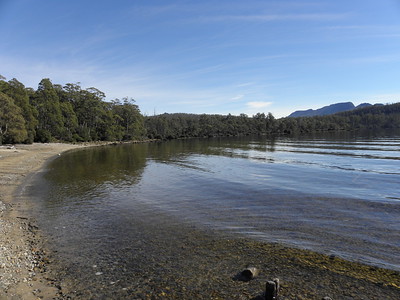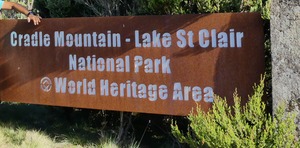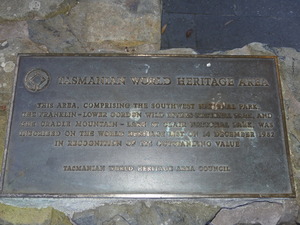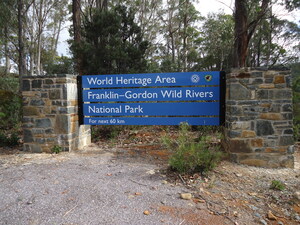Tasmanian Wilderness

The Tasmanian Wilderness constitutes one of the last expanses of temperate wilderness in the world and a cultural landscape for Tasmanian Aboriginal people.
Tasmanian Aboriginal people have lived here for approximately 40,000 years, of which traces can be found in prehistoric cave sites. Its nature is of exceptional beauty, with various distinctive landforms ranging from the alpine to wetland and coastal ecosystems. It includes some of the longest-lived trees in the world and is home to several marsupial carnivores.
Community Perspective: The lakes of Dove and St. Clair (part of the Cradle Mountain/Lake St. Clair National Park) are the most accessible option for a short visit, and you may spot platypus, wombat and echnidna there. Shandos has given an overview of 5 of the included reserves.

Map of Tasmanian Wilderness
Community Reviews
Shandos Cleaver

The Tasmanian Wilderness WHS is huge, covering nearly a quarter of the island of Tasmania. Within the WHS are included seven national parks and multiple other conservation areas. The below reviews concentrate mainly on Cradle Mountain-Lake St Claire National Park, which is deservedly a highlight, but I want to share some more ideas for exploring this WHS, based on my three visits to Tasmania over the years.
Mount Field National Park: The easiest part of this WHS to visit from Hobart is actually Mount Field National Park, less than a 2 hour drive from the centre of Hobart. Compared to the other parks it's not that wild, but we still managed to hear quolls when I camped here as a child and took a wildlife walk after dark. The highlight of the park is Russell Falls, easily accessible on a 25 minute flat walk, and still impressive when I revisited in 2020. There's also the longer 6km Three Falls Circuit walk or drive up to the alpine area.
Southwest National Park: This huge national park is 6183 km² in size, over twice the size of Luxembourg! And of course it's entirely roadless. The main way to access the park is on the remote South Coast Track. But for a small taste, you can drive 2 hours south of Hobart to Cockle Creek, where there are camping facilities. It's also the starting point of the 16km return walk to South Cape Bay, which I hiked as a kid with my family.
Franklin-Gordon Wild Rivers National Park: A huge turning point in the environmental movement in Australia were the protests against building a dam on the Franklin-Gordon River, which luckily never went ahead. The best way to explore this spectacular river is on a river cruise from Strahan, on the west coast of Tasmania. Unfortunately, my memories from the cruise as a child are rather hazy, and I didn't revisit this area on my most recent trip to Tasmania in 2020. (On the cruises, you'll likely also see the remains of the penal colony in Macquarie Harbour, which were not included as one of the Australia Convict Sites.)
Mole Creek Karst National Park: On the northern side of the park is Mole Creek, home to a riverside campground where I've camped with my family twice. I've visited the two main caves in the park as a kid, but if you're over visiting the various caves on the World Heritage list like I am (except for the really special ones), give these ones a miss and concentrate on the rest of the park.
Cradle Mountain-Lake St Claire National Park: This national park, specifically the northern end, was the main place I visited in this WHS in 2020 with my husband, who was visiting Tasmania for the first time. It shouldn't be missed! Depending on the time of year/time of day, you may need to take a shuttle bus to Dove Lake. We drove down in a campervan during the evening, for photos of Dove Lake, but returned on the shuttle bus the next day for hiking.
We hiked the Cradle Mountain walk, which is definitely a tough all-day hike, especially the clambering over boulders towards the summit. For an easier experience, the circuit around Dove Lake is a lot less challenging but still offers great views. (We completed part of the circuit at the end of our hike.) If you're wanting a tougher experience, there's the multi-day Overland Track, between Dove Lake and Lake St Claire.
While staying at Cradle Mountain, I recommend visiting the Devils @ Cradle Wildlife Park. We did an after-dark experience and the Tassie Devils are fascinating! I've also visited the Lake St Claire end of the national park before, but didn't find it quite as spectacular.
If driving south from Cradle Mountain, if you take route A5 past the Great Lake, it's a short detour to Liffey Falls State Reserve (gravel road so maybe not if you have a hire car), plus you'll pass along the edge of the Great Western Tiers Conservation Area and Central Plateau Conservation Area (also included in the WHS). I haven't yet had a chance to visit Walls of Jerusalem National Park and Hartz Mountains National Park, which are home to some great hiking trails (Tasmania's speciality!)
Clyde

I visited this WHS in January 2018 and spent 4 days in Tasmania exploring by rental car. Of the 8 national parks/state reserves inscribed, I visited Cradle Mountain/Lake St Clair National Park.
It is quite a drive on very good condition winding roads to get there. The only stretch on the heritage highway is littered with speed cams so make sure to respect the speed limit or you'll have an unwanted souvenir. To avoid some of the queues I paid the national park pass for my car online and printed it beforehand. Upon arrival at the Cradle Mountain NP Visitor Centre (which closes at 4pm) and huge parking lot, I registered and I was given my day tickets. A very efficient hop on hop off shuttle service is offered (which runs till 7pm).
The least popular stop is the one at Snake hill which as the name suggests is the best place to encounter some snakes from the boardwalk. It is worth stopping at the Ranger Station for some information on the park and trails. The UNESCO WHS inscription plaque can be found there but is oddly placed as part of the stone benches - so unknowingly people might be sitting on it! A little walk up the street from here is another metal sign displaying WH status and a quiet trail through small waterfalls which leads to the enchanted walk were we saw rabbits, wombats and lots of parakeets.
The last stop is at Dove Lake were there are several walks with great views of Cradle Mountain. Arriving in the morning, we opted to walk in a clockwise direction. The iconic views of Cradle Mountain can be enjoyed from all around the Dove Lake Circuit and not only from Glacier Rock, which seems to be the only spot where most tourists gather. The circuit is 6.2km long and if you keep your eyes peeled and keep as quiet as possible, you might be lucky to spot some of the abundant wildlife there is here. We were lucky to spot an echidna, wombats and a tiger snake just from the boardwalk. The northern section called the Ballroom forest was blooming with pink mountain berries and Tasmanian snow gums. For the more adventurous hikers, the trail to the summit of Cradle Mountain is 12.8km (6-8hrs return) and the trail to Cradle lake is a 5.7km circuit. We also ventured to a stretch of the cradle valley boardwalk but turned back after spotting a couple of intimidating lowland copperhead snakes.
Apparently from 1st October to 31st May it's booking season and an overland track pass is charged in addition to the park entry fee. To avoid overcrowding, short-term overnight hikers are given specific tracks and accomodation choices. However, when we visited (on a bright sunny day), the only place which was crowded at times was glacier rock. Especially towards the northern sections, there were times were we were practically alone for almost an hour and we really enjoyed the peaceful and outstanding scenery (photo).
Tasmania is one of the last temperate wilderness areas in the Southern Hemisphere with pristine habitats for plants and animals found nowhere else in the world, including many threatened species. The glacially formed landscapes are of exceptional beauty and reveal a rich and complex geology - a rich legacy of humanity's interaction with the land dating back to the Ice Age.
An important tip when visiting Cradle Mountain National Park is to plan ahead and prepare a packed lunch or stock up your fridge for dinner as there aren't many options after 4pm. The best light on a sunny day is in the late afternoon just before sunset which was around 7pm when we visited. Many Australian tourists came straight to the Dove Lake area by car just to enjoy the view. Since we wanted to see the Tasmanian devil we followed a ranger who was conducting a guided night time walk and managed to spot one lazing about in its burrow. We also saw many possums, kangaroos and an endemic Tasmanian pademelon which come out to feed at night time.
Other scenic spots worth visiting (non-WHS) if you have time in Tasmania are the orange lichen-covered granite boulders of the Bay of Fires, the Wineglass Bay Lookout at Freycinet Peninsula and Australia's oldest bridge and delicious scallop pies at Richmond. The heritage highway also offers an easy way to visit Tasmania's 5 inscribed convict sites (as well as several others). All in all Tasmania is one of Australia's top WHS and nature destinations.
John booth

Because of the limited public transport in Tasmania I travelled around the island by campervan. This enabled me to see remote areas of the Tasmanian Wilderness, especially at night when most of the wildlife is out foraging.
At the Cradle Mountain NP I used the Park's shuttlebuses to reach Dove Lake. Here I saw echidna and wombats, as well as a pair of platypus in the shallows of the lake. In the early morning my van was surrounded by wallabies.
From Strahan I took a boat trip up the Gordon River to see the remining stands of Huon Pine in that area.
At Lake St Clair I took a ferry to Narcissus Bay at the northern end of the lake. Here there was some interesting mountain scenery (though nothing as dramatic as in New Zealand's Southern Alps). Wombats and echidnas were common here too.
In the Southwest NP I visited Lake Pedder and the surrounding mountains.
The only Tasmanian Devils I saw were in a reserve near the Port Arthur Convict Settlement.
Els Slots

The Tasmanian Wilderness WHS occupies a large part of Tasmania. For a day trip from the Tasman capital of Hobart, Lake St. Clair (part of the Cradle Mountain/Lake St. Clair National Park) is the most accessible option. I rented a car and drove out there in 2.5 hours. It's a fine drive through the island's hilly landscape, with plenty of sheep along the road as well as signboards to watch out for kangaroos, wombats or Tasmanian devils.
I arrived at the visitor center at about 11 a.m. There's a 24 AUS dollar entrance fee (per car) that you have to pay there. And you can take your pick among the many walking tracks in the area. I was looking for a hike of about 3 to 4 hours. The one to Shadow Lake fitted nicely, so it seemed. So after having a quick look at the vast Lake St. Claire, I got going. The track is signposted very well. I did not encounter any other travellers, though there were about 10 cars in the car park. You can do hikes that vary in length from half an hour to 5 days, so it will not get crowded easily on a track.
After walking for about 45 minutes on a small path through the forest, I suddenly realized that I was not enjoying it. There were trees, trees and more trees around me. Most of them are Eucalyptus, common in Australia. No colourful birds, no birds at all except for black crows. And no mammals either. So I easily convinced myself to turn back and go find something else to do here.
On the way out I was already attracted by the sign "Platypus Bay" - the Platypus an animal that I would really like to see. There's a short circular walk that you can do that brings you to the bay where they are often seen. You just have to sit still and be very quiet, the instruction boards told me. Platypus Bay turned out to be a very fine beach at Lake St. Claire. So I sat down at a dead tree trunk, ate my lunch, and stared at the water. Supposedly you have to look for a crocodile kind of movement in the water. Unfortunately, I saw nothing move in the half-hour that I sat there.
At the visitor centre of Lake St. Claire they have journals where each visitor can write down his sightings of wildlife. People had seen wallabies, Tasmanian devils, wombats and echidna. And almost every day a Platypus or two at the Bay. I was not so lucky and returned back to Hobart with only memories of dark forests. You definitely need more time on the ground and an overnight stay to see any wildlife here.
pauline ferguson
Cradle Mountain is another world!! stunning scenery and wildlife - does not need to change. we went there in winter and had just missed a snowfall but it was still magestic and magical. everyone should go there for peace of mind and to get away from our hectic lifestyles
Rob Wilson
Gorgeous! This must be one of the most beautiful places on the entire planet. The Tasmanians should be very proud of their state. The Overland Track between Cradle Mountain and Lake St. Clair must be one of the finest hikes on Earth. I can't recommend it higher. But, if you do attempt this hike, please be fully prepared. The weather in this part of the world can be absolutely lethal. Oh and also, Tasmania, please STOP THE LOGGING!
Ben Fraser
An area of spectacular natural beauty. Easily accessable at Cradle Mountain, and Lake St Claire. The Franklin river is amazing and it is scandelous that there was pressue to flood and destroy it in the 1970's. The flooding of Lake Pedder, which is also part of the World heritage area, was an unbelievable act of government anti environment policy
Community Rating
- : Milan Jirasek Liverpool1023 KeithBailey CampbellME Ingatastic Michaelsballard Linz BenReeve Little Lauren Travels Mihai Dascalu MoPython Roel Sterken Jeanne OGrady Zoë Sheng
- : RahulSharma Nicole Lampos Sutul Kasileigh Jezza Clyde
- : ReallyDeepThoughts Nykri Roland Ko9757 Shep894 George Gdanski Naim Y Tamara Ratz Alexander Parsons Tango Jarrod_Byham Shandos Cleaver Bill Maurmann
- : Eric PK Wimmy Krijn Els Slots
- : Gary Arndt Allnamesused
- : Jon Opol
Site Info
- Full Name
- Tasmanian Wilderness
- Unesco ID
- 181
- Country
- Australia
- Inscribed
- 1982
- Type
- Mixed
- Criteria
-
3 4 6 7 8 9 10
- Categories
- Archaeological site - Prehistoric Natural landscape - Forest
- Link
- By ID
Site History
1989 Name change
From "Western Tasmania Wilderness National Parks" to "Tasmanian Wilderness"
1989 Extended
To include 2 more national parks (Walls of Jerusalem, Hartz Mountains) and additional areas
1982 Advisory Body overruled
ICOMOS stated "that the elements of the cultural heritage included in the proposal for the Western Tasmania Parks do not, in themselves offer sufficient reason to inscribe this cultural property on the World Heritage List but simply constitute new positive elements which supplement the already favourable report of IUCN" - however it was inscribed on 3 cultural criteria
1982 Inscribed
Site Links
Unesco Website
Official Website
In the News
Connections
The site has 34 connections
Damaged
Ecology
Geography
History
Human Activity
Timeline
Trivia
WHS Names
WHS on Other Lists
World Heritage Process
Visitors
156 Community Members have visited.
The Plaque
 (photo by Clyde)
(photo by Clyde) (photo by Clyde)
(photo by Clyde) (photo by Jarek)
(photo by Jarek)